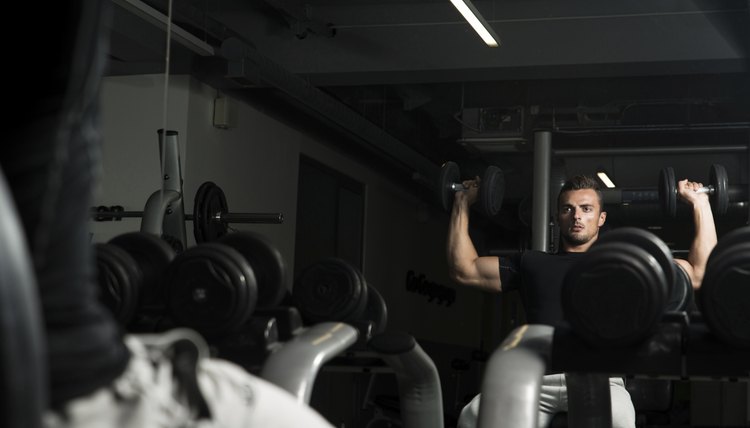What does fact checked mean?
At SportsRec, we strive to deliver objective content that is accurate and up-to-date. Our team periodically reviews articles in order to ensure content quality. The sources cited below consist of evidence from peer-reviewed journals, prominent medical organizations, academic associations, and government data.
The information contained on this site is for informational purposes only, and should not be used as a substitute for the advice of a professional health care provider. Please check with the appropriate physician regarding health questions and concerns. Although we strive to deliver accurate and up-to-date information, no guarantee to that effect is made.
Eccentric & Concentric Motions in a Shoulder Press

Your muscles operate in three basic movements: eccentric, concentric and isometric. Weight training and most cardiovascular exercises incorporate both eccentric and concentric motions. Concentric motions occur when your muscles are shortened and eccentric motions involve the lengthening of your muscles. Your elbows usually are flexed as you bring a weight closer to your body in concentric movements. Eccentric motions occur when you move the weight away from your body in any kind of weightlifting exercise, including the shoulder press. Isometrics are not really motions, but instead comprise a holding pattern when the tension on your muscles is increased with no movement.
Basics
The shoulder press incorporates both eccentric and concentric motions as well as isometric motions when you hold the weight above your head. Lying on a bench or standing, you usually begin the exercise with an eccentric motion by grasping a weight and pushing it up. You may include an isometric in the exercise if you hold the barbell above your head. Isometrics are an integral part of complete weight training. While using manageable weights, you then perform the concentric motion when you lower the weight back to the starting point.
Control
Concentric motions are nearly always under your control, except in the shoulder press. For example, if a free weight is too heavy as you perform bicep curls, you have to exert enough pressure to bring it up toward your body. You may experience an involuntary eccentric motion if the weight pulls your arm away from your body due to its heaviness. While performing the shoulder press, you use muscle resistance to push the weights away from your body. When the weight is too heavy, it may press your arms back down against your will, causing you to lose control of your concentric movement.
Assistance
The shoulder press is an exercise aimed at building the muscles attached to your shoulder joints as well as your pectoral and abdominal muscles. Your arm muscles also trigger supporting muscle contractions with the eccentric and concentric movements. As you build intensity in your workouts, you most likely will start lifting heavier weights. To prevent injuries, perform both the up and down movements while a spotter stands nearby. If you lose control on the concentric downward motion, you could drop the weight on your chest. The eccentric upward motion with heavier weights may require a little assistance until you get stronger. Even a light touch from a spotter can help you lift heavier weights.
Warning
The shoulder press can lead to a host of injuries. Both motions involved in the press place the shoulders under enormous pressure, especially when you perform the exercises quickly without the isometric component. Many of the complications associated with the shoulder press result from overuse and can include rotator cuff nerve impingements and tendonitis in your elbows. Joint sprain, torn ligaments and inflammation can occur from overuse of concentric and eccentric shoulder press movements. Proper warm-ups, sufficient rest between training sessions and effective exercises to strengthen supporting muscles in your abs and arms can help alleviate many of the problems associated with the pressure you put on your shoulders in the weighted press.
References
- American Council on Exercise: Standing Barbell Shoulder Press
- Hody S, Croisier JL, Bury T, Rogister B, Leprince P. Eccentric muscle contractions: risks and benefits. Front Physiol. 2019;10:536. doi:10.3389/fphys.2019.00536
- Franchi MV, Reeves ND, Narici MV. Skeletal muscle remodeling in response to eccentric vs. concentric loading: morphological, molecular, and metabolic adaptations. Front Physiol. 2017;8:447. doi:10.3389/fphys.2017.00447
- Padulo J, Laffaye G, Ardigò LP, Chamari K. Concentric and eccentric: muscle contraction or exercise?. J Hum Kinet. 2013;37:5–6. doi:10.2478/hukin-2013-0019
Writer Bio
Linda Ray is an award-winning journalist with more than 20 years reporting experience. She's covered business for newspapers and magazines, including the "Greenville News," "Success Magazine" and "American City Business Journals." Ray holds a journalism degree and teaches writing, career development and an FDIC course called "Money Smart."
